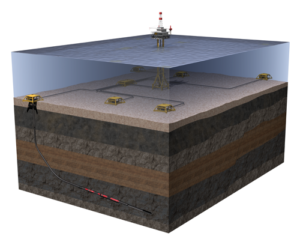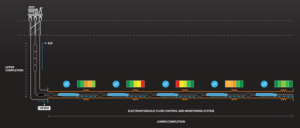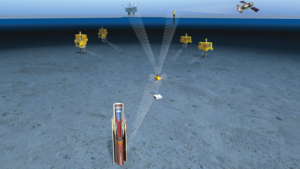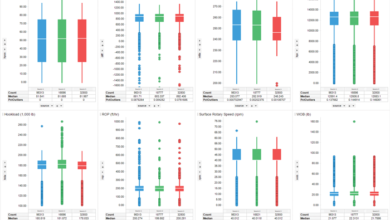Intelligent completion advances target improved reliability in HPHT conditions, simplified deployment
New technologies helping to provide real-time fluid characteristics, faster or remote actuations and optimized production over life of the well
By Kelli Ainsworth, Associate Editor

Higher-cost intelligent completion systems face obvious challenges in the current low oil price environment, with all sectors pushing for cost reductions. However, operators continue to show interest in these completion systems – and their remote monitoring and control capabilities – to avoid costly interventions later on and improve recovery over the life of the well and field. “Through the years we’ve had new operators coming to us with interest because they see the benefits and value,” Bruce Gavin, Senior Product Line Manager – Flow Control/Intelligent Completions for Halliburton, said.
Particularly for complex deepwater wells, which can cost up to $200 million to drill, cost-conscious operators are increasingly recognizing the importance of being able to improve returns on their well investments. “As far as deepwater projects, clients are much more cost focused. Some projects are delayed, and some are completely canceled. That puts more pressure on service companies to provide more cost-effective solutions,” Mr Gavin said.
In particular, operators are demanding intelligent completion systems that are reliable in HPHT conditions – temperatures above 300°F and pressures more than 10,000 psi – for the life of the well. “They demand the equipment to function reliably for the life of the well, which is often expected to reach 20-year life,” Mr Gavin said. “We’ve been designing equipment for 20-year life since the very early days of intelligent completions. It becomes more of a challenge with higher pressures and temperatures. Reliability is key.” Higher temperatures can impact the reliability of the electronic components, while high pressures require metal components, such as valves and seals, to have higher yield strength and improved burst and collapse ratings.
On the temperature front, service companies have already made significant progress, Mr Gavin said. In 2016, Halliburton commercialized electronics for its downhole gauges that can be installed in wells with temperatures of up to 200°C, up from a previous limitation of 175°C. These gauges provide downhole flow monitoring in the company’s SmartWell intelligent completion system, originally launched in the late ’90s. “Downhole gauges have gone from very large printed circuit board-type technologies to hybrid electronics, and that’s been a big enabler to withstand higher temperatures.” The company has also upgraded the interval control valves (ICVs) in the SmartWell system for higher-pressure environments, with differential pressures of up to 15,000 psi.
Leveraging electronics and hydraulics
Some companies are developing electrohydraulic technologies for intelligent completions that allow more complex drilling programs and completion designs while simplifying the completion deployment by reducing the number of control lines. Traditional hydraulic systems typically require a control line for every zone an operator wishes to complete. An electrical line for flow monitoring and/or downhole gauges is needed, as well. Running these cables can hamper the completion deployment, said Steve Dyer, Product Line Manager – Intelligent Completions and Valves at Schlumberger.
To address this challenge, in 2015 Schlumberger launched the Proteus electrohydraulic flow control and monitoring system, which provides downhole control and monitoring across each completed zone while reducing the number of control lines required. It is a single unit that contains a downhole electrohydraulic control module, dual pressure and temperature quartz gauges, position sensors and a multiposition flow control valve, which can be set to eight positions, including fully open and fully closed.
In a fully hydraulic system, each individual flow control valve requires its own hydraulic line. This makes it difficult to install in a well with more than three or four zones. In contrast, the Proteus system is controlled through a flat pack that bundles two hydraulic lines and one electrical line. Up to nine Proteus stations can be powered from a single flatpack, with each station controlling one zone.

Downhole monitoring is provided through dual quartz pressure and temperature gauges, which transmit tubing and annulus pressure and temperature readings from the zone to surface in real time. Further, the electric cable provides bidirectional telemetry, so system health information can be regularly transmitted to surface for prognostic monitoring.
In 2015, the system was installed in a 15,000-ft five-lateral onshore well in the Middle East. The operator wanted the ability to choke back or shut off production if any laterals began producing unwanted water or gas. Conventional hydraulic systems were ruled out because of the complexity of installing six hydraulic lines. Additionally, the operator wanted a solution that would actuate quickly, as it typically takes 45-50 minutes for a hydraulically controlled valve to actuate. Flow control valves on the Proteus system can be switched to any position in a single actuation in under two minutes, rather than cycling through every position.
The Proteus system was installed in the well as a part of the intelligent completion and run with the Schlumberger WellWatcher Advisor real-time intelligent completion software. Because fewer control lines had to be handled and spliced, installation and onsite testing were completed in under a week. Mr Dyer estimates the reduced control lines shaved approximately two days off the operation. Additionally, all five valves installed in the well were actuated from the full-close to the full-open position in less than seven minutes. Schlumberger estimates this saved the operator 3.6 hours compared with a conventional hydraulic intelligent completion system.
Later this year, Schlumberger will begin field-testing a downhole electrohydraulic wet mate (HEWM) connector. When combined with the Proteus system, the connector will enable multi-trip completions. Running a two-trip completion with the intelligent completion as a part of the lower completion enables the operator to workover the upper completion without having to retrieve the intelligent lower completion. “It allows you to keep that control and instrumentation down in the lower completion close to the pay zone, isolating the zones during the workover operation. It makes it much more efficient to change out an upper completion,” Mr Dyer said. Further, pulling an upper completion requires only a light workover rig rather than a full drilling rig.
The new downhole connector combines an existing Schlumberger hydraulic wetmate connector released in 2010, and an inductive coupler connector that was released in 2015 as a part of the Manara production and reservoir management system. “That allows us to take the power of hydraulic devices, couple them with the flexibility of electric for monitoring and multi-dropping, and place them into the lower completion,” Mr Dyer said. The first field tests for the connector are scheduled for later this year.
Life cycle monitoring
Monitoring fluid properties inside the wellhead annuli during drilling, completion and production of subsea wells continues to be a challenge. TechnipFMC began developing the Annulus Monitoring Service (AMS) in 2011 and will commercially launch the system in Q3 this year. The system uses electromagnetic waves to transmit real-time data on the temperature and pressure of fluid within the wellhead annuli to surface. The AMS is integrated with the wellhead, rather than with the completion infrastructure, so it’s able to transmit data throughout the well’s life cycle, from drilling into production, Justin Rodriguez, Director of Technical Services for Subsea Drilling, said. “The system comes online as soon as the casing hanger has landed. Basically, from the moment that you’ve actually created the annulus itself, you have data coming back.”

Getting real-time data on the temperature and pressure of fluid in the wellhead annulus can be difficult due to API 17D, which prohibits penetration through the high-pressure housing of subsea wellheads. This is to ensure there are no potential leak paths in the high-pressure housing. “All of the annuli that are critical to the function of the wellhead system are within that high-pressure housing, so because the industry doesn’t allow us to drill a hole or create any type of penetration through that body, it pretty much makes it such that we don’t have any access to those annuli directly.”
Understanding the properties of the fluid within the wellhead annuli is crucial throughout the life of the well, Mr Rodriguez said, to avoid collapsing or even rupturing one of the casing strings due to pressure buildup. Without the ability to access the annuli directly, the industry has traditionally relied on simulation software to predict fluid behavior based on formation temperatures and pressures. However, there has been a dearth of real-time data on fluid temperature and pressure, he said.
The AMS utilizes an electromagnetic communication system similar to the technology used in cell phone charging mats. The system allows the AMS to transmit data across all the barriers of the wellhead. Multiple off-the-shelf sensors are installed within the wellhead, on the casing joints just below the casing hangers, to detect fluid temperature and pressure. These sensors transmit an electromagnetic wave to a transponder situated on the outside of the wellhead. The transponder receives the signal, and a software package scrubs and converts the signal into data, then stores it.
“All of the data is stored locally at the wellhead within the transponder. If, for whatever reason, we can’t complete the acoustic loop or we lose communications via the acoustics, the data is always there on the wellhead, so it can be grabbed as soon as you can reestablish communication links to the wellhead,” Mr Rodriguez said. Inclement weather, for example, might require the rig to move off site for safety reasons, which would cause the rig to lose communication with the repeater.
The transponder sends the data via conventional open-water acoustic telemetry to an acoustic repeater located on the seabed, within 500 m from the wellhead. The repeater then sends an acoustic signal to a transceiver located on the rig. One acoustic repeater can service up to 15 wells with the AMS installed, as long as each well is within 500 m of the repeater. The BOP and riser influence the specific placement of the repeater, as the repeater needs to be far enough away from the BOP to ensure that it does not block the acoustic transmission.
Because the AMS doesn’t depend on any other completions infrastructure to operate, it can be installed during the drilling phase, providing real-time data throughout the drilling, completions and production phases of the well’s life cycle. Gathering data on fluid characteristics during drilling can help operators gain a better understanding of their reservoir before it begins producing, Mr Rodriguez said. “You can put that back into your models, and it gives you the ability to get a much more refined, accurate understanding of how those annuli are going to behave during production.”
During the production phase, lifetime monitoring provides operators with confidence in having accurate information about the behavior of the annulus during specific events. “This is just something we don’t have today, and we make decisions that limit production and operating time based on assumptions. This system has the potential to provide information through the life of the well that we haven’t had before, and that information can be used to make better decisions about how to operate a well,” Mr Rodriguez said.
The first installation of the AMS took place last year in an exploration well in the South China Sea for Petronas, Mr Rodriguez said. Three electromagnetic receivers were affixed to the 30-in. conductor pipe on the rig floor. Then, the conductor pipe and low-pressure housing were lowered through the rotary table to the permanent guide base, which was located on the moonpool’s spider beams.
There, cables were made up between the receivers on the conductor pipe and the transponder. After that, the conductor pipe was installed in the well. The acoustic repeater was then installed on the seafloor approximately 10 m from the low-pressure housing.
The casing annulus sensors had been pre-installed on a 13 3/8-in. casing hanger. Once the hanger was run at the wellsite, the system began transmitting. It provided continuous transmission of real-time data for 16 days, until the exploration well was plugged and abandoned.
The system currently provides only real-time temperature and pressure measurements. However, more measurements – such as data on fluid composition or cement level – could be provided based on operator needs, according to the company.
Intelligence under pressure

Offshore wells are getting deeper, and with that increased depth comes higher pressures and temperatures. In plays like the Lower Tertiary in the US Gulf of Mexico, downhole differential pressures can reach 15,000 psi. This differential pressure can change dramatically over the life of the well, Mr Gavin of Halliburton said. “During installation, reservoir pressures are high, which creates high differential pressures across the equipment,” he said. “High differentials in a well can have some negative effects on sealing components and require higher applied pressures in order to operate the equipment in the wells.”
To tackle these conditions, in August Halliburton released a new version of its SmartWell intelligent completion system. It now features ICVs that have been qualified for differential pressures of up to 15,000 psi and downhole gauges qualified for temperatures up to 200°C. Previous differential pressure ratings for flow control products ranged between 10,000 psi and 12,500 psi, although the absolute pressure ratings are much higher. Halliburton’s permanent downhole gauge systems are qualified for downhole pressures as high as 30,000 psi.
Like the previous-generation ICV, the new 15K version features a proprietary debris-tolerant metal-to-metal seal. The valve can be set in eight positions, from fully closed to fully open. Position sensors on the valve provide real-time feedback confirming that the valve is in the desired position. The 15K valves can be controlled by Halliburton’s range of control systems, including the Imperium platform and the electrohydraulic SmartPlex system, which requires only two hydraulic and one electric line to actuate valves in up to 12 zones.
When designing the new ICV, the company had to ensure that the valve’s metal-to-metal sealing mechanisms would actuate in a high-pressure environment, which required extensive temperature, pressure, debris and erosion testing. “It’s not as simple as just running calculations like burst and collapse,” Mr Gavin said. “You have to fully understand how each component of the system interacts and the impact these interactions have on the sealing mechanisms.”
Testing was performed at the individual component level first. “We don’t just test it one time, especially in the case of electronics and sealing mechanisms,” Mr Gavin said. Instead, some components are cycle-tested up to 300,000 times to obtain a true understanding of how long they will last. A full-scale test was then conducted, which was designed to simulate the life of the well. “In the case of an ICV, we cycle the amount of times an operator expects to see over the 20-year life of the well,” he added. “It’s not only pressure cycles but temperature cycles, as well.”
Field-testing of the 15K SmartWell system recently concluded, although data from the tests was not yet available. Halliburton said it expects to install the first commercial systems in Q4 2017 or Q1 2018 in the Gulf of Mexico.
Startup optimization
In June, National Oilwell Varco (NOV) announced the acquisition of the ReAct remote activation technology from Omega Completion Tools. The technology, originally launched in the mid-2000s, allows remote activation of sliding sleeves via pressure signatures or at preset times.
“It provides the opportunity to optimize the well startup phase or early phase production,” said Tore Sørheim, Region Manager – Completion Tools Europe for NOV. “You can tell the well to start producing the toe section first, and then you can move back to the heel in a sequential manner so that you get the most efficient cleanup and startup of a well.”
The system is run without any control lines. Rather, it is programmed to actuate when it detects a specific pressure signature – for instance, slightly elevated pressure for five minutes followed by slightly decreased pressure for five minutes. It can also be actuated at preset times and dates.
A ReAct sleeve can also be run in either an open or closed position. “You can install multiple sleeves in the well, which are programmed in different ways or programmed to actuate with different types of pressure signatures, so you can talk to multiple ReAct sleeves and have them actuate in the sequence that suits your application,” Mr Sørheim said.
The absence of control lines means that no permanently installed topside equipment, such as hydraulic power units, is needed to operate the system. “That lowers the system cost,” he said. “It’s also very time consuming to run the completion with multiple control lines along the tubing string.”
Early this year, an operator in the UK North Sea used the ReAct technology, which is rated for up to 150°C (300°F), to optimize the start-up of a 20,000-ft horizontal well, located in 500 ft of water. From previous wells in the area, the operator knew the toe section of the well tended to be the least productive and that cleaning out that section first would make the entire well more productive. The operator programmed the ReAct sleeve in the toe section to open first, so that section would be cleaned out and start producing first.
The other ReAct sleeves in the well were set to open sequentially from toe to heel with a few days or weeks in between each sleeve opening. The opening sequence was programmed based on the reservoir characteristics in each section of the well.
“By introducing the ReAct technology to these well completions, the operator saw a much better contribution profile for the entire horizontal, so they realized the value of all the drilled footage that they have,” Mr Sørheim said. In wells where the operator doesn’t know enough about the geology of a field or reservoir to determine preset times, pressure signatures can be used to actuate the sleeves. DC
SmartWell is a registered term of Halliburton. Proteus, WellWatcher Advisor and Manara are registered terms of Schlumberger. Annulus Monitoring Service is a registered term of TechnipFMC. ReAct is a registered term of NOV.





